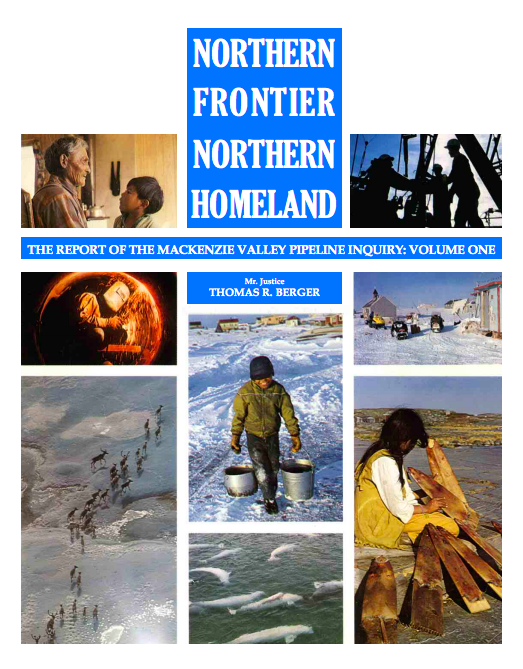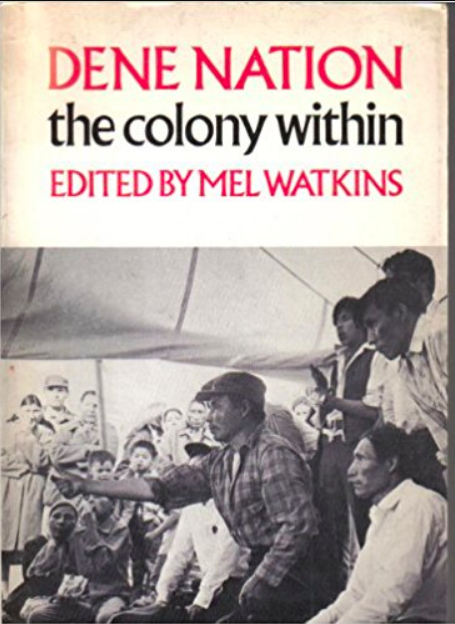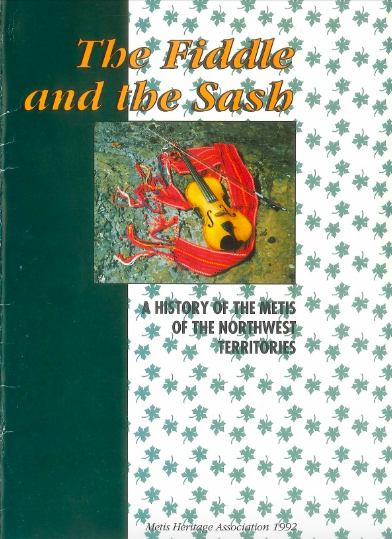Hearing Record Tuesday December 8, 1992. Northern United Place Hall, Yellowknife.
This set of RCAP hearing minutes contains numerous testimonials, including a piece by Betty Harnum that speaks to the history of language and legislation in the NWT. In her testimony, she advocates for increased interpretive services, more accessible language funding, more elders in schools, Aboriginal language immersion classes, and language teacher certification. She also speaks to the difficulty that interpreter/translators face with regard to negotiations and unfamiliar terminology (e.g., “extinguishment”) and how more training is needed. Thus far, Harnum comments, it has been very difficult to measure or quantify how much of an impact the Official Languages Act and its connected funding has had.
Access this Resource:
Royal Commission on Aboriginal Peoples. Hearing Record: Tuesday December 8, 1992. Northern United Place Hall, Yellowknife. Recorded by Stenotran, Ottawa (1992).
The Fiddle and the Sash: A History of the Metis of the Northwest Territories
The authors describe the history of subarctic Métis people, and begin by saying that there were approximately 7000 Métis in the Northwest Territories at the time of writing. NWT Métis culture comes from a mix of Red River Métis, Euro-Canadian, Slavey, Gwich’in, Dogrib, Chipewyan and Cree cultures. The first Métis in the NWT region were Hudson’s Bay or North West Company employees in the late 1700s and early 1800s, descendants of French, French-Canadians, and Ojibwa or Cree women.
Access this Resource:
Read the full PDF from academia.edu.
Yanik Koosel, Bunny, Ingrid Kritsch and Gordon Lennie. The Fiddle and the Sash: A History of the Métis of the Northwest Territories. Yellowknife: Métis Heritage Association, 1992.
The Sahtuotine Long Ago
These two texts provide stories and images describing lifestyles of Sahtú Dene peoples long before they met any Europeans. They describe food, subsistence practices, economy, leadership, travel, hunting and trapping, seasons, gathering, consensus, stories, roles of different age groups, healing, laughter, traditions, dancing, drumming, spirituality, games, and persistence. The books are bilingual, providing both English and Dene versions of each topic.
Access this Resource:
Search for volumes one and two at a local library.
Dene Resource Book One : Hunting and Gathering
Dene Resource Book Two : Camp Life
Vandermeer, Jane Modeste, Mitsu Oishi, and Fibbie Tatti. The Sahtuotine Long Ago. Two Volumes, Government of the Northwest Territories Department of Education, Yellowknife NT, 1991.
When the world was new: Stories of the Sahtú Dene.
When the World was New compiles stories from the Sahtú region, ranging throughout different time periods and dealing with themes of tradition and change. The stories incorporate elements such as handgames, medicine, prophecy, industrialization, trade, subsistence, and Yamoria.
From Description:
A collection of stories of the Sahtu Dene people of the Mackenzie Valley, Northwest Territories, both traditional and contemporary, dealing with history and cultural traditions as well as adaptations to social change. Oral history in book form, covering five generations of the Blondin family of Fort Franklin.
Read the CBC Books article on this work: http://www.cbc.ca/books/when-the-world-was-new-stories-of-the-sahtu-dene-1.4212883
Access this Resource:
Search inside the book on Google Books (full preview not available).
Search for a hard copy from a local library or bookstore. ISBN 9780919315211.
Blondin, George. When the world was new: Stories of the Sahtú Dene. Yellowknife: Outcrop, 1990.
Johnny Neyelle
This short profile gives a brief biography of Jonny Neyelle, including his early history, his first and second marriages, his language abilities, and his skill with carving, music, and instruments.
Access this Resource:
The University of Calgary hosts an open access version of this article, and so does JSTOR.
Stable URL: http://www.jstor.org/stable/40510733
Lange, Lynda. “Johnny Neyelle.” Arctic 41, no. 3 (1988): 252-253.
Prophets, Priests and Preachers: Dene Shamans and Christian Missions in the Nineteenth Century
Abel presents the stories of Dene prophets, men and women who travel to a different world and return with lessons for humanity. Prophets, shamans, and medicine people existed before European contact, perhaps under different names. Post-contact, missionaries were concerned about Dene spiritual leaders. Prophets began to use the language of Christianity and thus claimed an authority equal to, or greater than, missionaries.
Abstract:
Throughout the nineteenth century, European and Canadian observers recorded instances of “prophets” arising among the Dene in the northwest. These men and women reported having travelled to the land of the spirits or to heaven, where they learned new rules for human behaviour which would bring about a change of circumstances for the better. Missionaries of the Church Missionary Society and particularly the Oblates of Mary Immaculate were concerned about these events and interpreted them in a variety of ways. Anthropologists and historians have considered similar postcontact events in North American Indian societies as “revitalization movements” and “crisis cults.” These concepts are examined and found somewhat misleading when applied to the Dene prophets. Instead, the activities of these prophets are interpreted as manifestations of traditional cultural responses to the various pressures of life in a harsh northern environment.
Access this Resource:
doi:10.7202/030954ar
Full text available from Érudit: https://id.erudit.org/iderudit/030954ar
Abel, Kerry. “Prophets, Priests and Preachers: Dene Shamans and Christian Missions in the Nineteenth Century.” Historical Papers 21, no. 1 (1986): 211-224.
Northern Frontier, Northern Homeland: Report of the Mackenzie Valley Pipeline Inquiry
This report details the findings of the Mackenzie Valley Pipeline Inquiry, including a significant assessment of a huge body of land use documentation and oral testimony from Dene peoples in the Mackenzie Valley region.

Access this Resource:
Read the full text from the Prince of Wales Northern Heritage Centre.
Read the full text from CAID.
ISBN: 0660007754
Berger, Thomas R. Northern Frontier, Northern Homeland: Report of the Mackenzie Valley Pipeline Inquiry, Berger Commission Report. Ottawa: Minister of Supply and Services, 1977.
Fort Good Hope
This short documentary film was shot during the Berger Inquiry, mostly at Fort Good Hope. It includes footage both of Justice Berger and of many speakers, including the Fort Good Hope chief and a K’asho Got’ine translator. It deals with the issues not just of development, but also of education, language, cultural skills, employment, and land skills.
Fort Good Hope, Ron Orieux, provided by the National Film Board of Canada
Cite this Resource:
Orieux, Ron. Fort Good Hope. Montreal: National Film Board of Canada, 1977.
Dene Nation, the colony within
This text presents a valuable overview and analysis of presentations made at the Mackenzie Valley Development in the 1970s. It contains material both from Dene peoples and from other researchers and involved parties.

One chapter of this book is "Country Food" by Scott Rushforth.
Access this Resource:
Borrow the full book online.
ISBN: 9780802063151
Watkins, Mel. The Colony Within. Toronto: University of Toronto Press, 1977.
As long as this land shall last: A history of Treaty 8 and Treaty 11, 1870-1939
Fumoleau presents a historical survey of the negotiations for Treaties 8 and 11 in Canada. He discusses both oral and written accounts, and continues by describing the implications of the treaties as they were signed and contested. Treaties 8 and 11 influenced the outcome of land and industrialization debates (such as the Mackenzie Valley Pipeline question) and the roles of non-Dene hunters and trappers. While Fumoleau’s history only extends to 1939, it sets the stage for land claims and self-determination struggles following in the second half of the twentieth century.
About the book:
A historically accurate study that takes no sides, this book is the first complete document of Treaties 8 and 11 between the Canadian government and the Native people at the turn of the nineteenth century. On the basis of those treaties, contested in the Mackenzie Pipeline debate, white fur-traders, trappers, and corporations gave themselves privileges of ownership with no regard to the Native claim and to the promise made to the Natives that they could live and hunt there "as long as the sun rises, as long as the river flows, as long as this land shall last." Historian René Fumoleau has delved into church and government sources to afford a clear picture of the negotiations for the treaties beginning in 1870 and their aftermath up to 1939. With an Epilogue by Joan Barnaby, the documents discussed in the book speak for themselves, implying a host of questions with both historical relevance and enduring significance.
Access this Resource:
Read the Google Books Preview:
Fumoleau, Rene. As long as this land shall last: A history of Treaty 8 and Treaty 11, 1870-1939. Toronto: McClelland and Stewart Limited, 1975.






 Phone: 867-374-4040
Phone: 867-374-4040 Email:
Email: